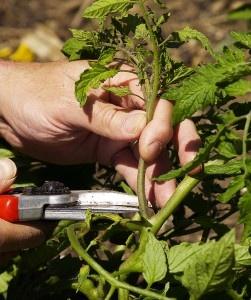“Should I prune my tomatoes?”
“If they’re the vine-types, yes. Especially the suckers.”
“What are suckers?”
I can’t count how many times I’ve had this conversation. “Suckers” on tomato plants are the growths that appear in the leaf axil between the leaves and the main stem. Some refer to this area as the “crotch” in the stem.
Pruning tomato suckers is more important with vine-type varieties (indeterminates), and less essential with bush-types (determinates). With determinate varieties, you need only prune suckers below the first fruit cluster, as suckers won’t negatively affect these plants in any way.
Technically, tomato suckers are new stems. If allowed to develop, they’ll even flower and bear fruit. However, suckers draw nutrients away from the main tomato stem, weakening it, and depriving already developed lateral shoots of the nutrition their developing flower buds and fruit require.
Suckers grow in sequence, from the bottom to the top of the tomato plant. The higher up on the plant a sucker appears, the weaker it is, due to a lower concentration of sugar. Tomato suckers are especially assertive in the heat of the summer when the plant is producing lots of fruit, so be diligent and keep pruning, because the suckers are siphoning off nutrients from the rest of the plant.
Read: How to prune tomato plants
How to prune tomato suckers
The basic method of removing tomato suckers is pretty simple – as soon as you see one developing, just pinch it off - grab it between your thumb and index finger, bend it back and forth, and it should snap off pretty easily. But that’s assuming the sucker hasn’t grown beyond three inches. If you’ve been a negligent gardener, and the sucker is over three inches and beginning to develop into a stem, it’s beyond pinching safely, as it will have toughened up a bit. Use a very sharp pruner or garden knife to excise the sucker (hey, it happens to all of us – see my pic above). If you try pinching it off when it’s this size, there’s a very good chance you’ll tear into the main stem, and/or create a large wound that will introduce disease into the plant (been there, done that).
There’s also a second method of pruning tomato suckers, called “Missouri pruning”. In this method, you remove all suckers that appear below the first fruit cluster. For all other suckers, let them develop two leaves, and then pinch or prune off the tip. This will stop the growth of the sucker, but allow the leaves to remain, which shades the tomato fruit below and aids in photosynthesis. Shading the fruits is helpful in avoiding sun scald.
In my book, Homegrown Tomatoes, I describe how to prune tomato suckers and other pruning techniques to increase fruit production: ”…remove any suckers growing in the crotch between the main stem and the leaves, but only remove those suckers that are below flower blossoms, not above. Even though tomato suckers left alone will eventually bear fruit, they’re actually side shoots and will intercept nutrients meant for the fruit above it. This diverting of nutrients reduces the size of the fruit on the sucker and the fruit above. Suckers will develop all season long, but if you get to them when they’re still small, about 1-3 inches, they’ll snap right off. Don’t let up on removing them.“
This article was originally written and published by Todd Heft, the founder of bigblogofgardening.com. Please visit his website for the original article.




